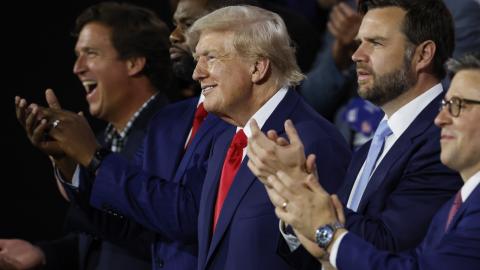" class="more read" target="_blank">View PDF
__This essay is part of a series exploring the importance of allowing flexible business models in the American economy.__
Producers of goods and services seek to sell them to consumers who are often distant and unknown. Producers reach consumers with a variety of distribution networks, including wholesale-retail networks, franchises, and direct sales. Although these distribution networks may appear unrelated, they have one factor in common: trust.
Consumers wishing to purchase a product or service often demand more than just a good price and good quality. They want to trust the transaction. In order to do so, the consumer must trust the product, the distributor, or the person making the sale.
Type 1: Trust in the Product Brand or Service Brand Some of the most iconic brands are products, such as CocaCola, Kleenex, or iPhone, but services can also have branded names. Thus, a generation ago, a photocopy was a Xerox and today, you search for something online by Googling it.
Part of the allure of a branded product or service is its familiarity. Practically everyone knows Coca-Cola, and its quality and characteristics are consistent. Coca-Cola has the same sweetness, carbonation, and ingredients whether it is sold in Atlanta, Georgia or the former Soviet republic of Georgia.
Consumers can trust that the quality and characteristics of a branded product will be the same no matter who the ultimate seller is. For distributors, this trust makes selling a branded product relatively easy, even if the product must sell at a premium relative to unbranded products.
Of course, developing and maintaining a widely known branded product is costly. Coca-Cola spends princely sums each year to market and advertise its products, in addition to quality control to ensure uniformity. Other companies selling branded products and services likewise spend large sums to advertise and ensure quality control. These costs are passed along to distributors and consumers, who are ultimately willing to pay for the trusted, branded product.
Service providers also brand their services and sell directly to customers. Citibank, Bank of America, and other nationwide banks sell nationally branded banking services to customers through thousands of retail branches across America. Customers trust these and other branded service providers. With few exceptions, these providers sell directly to consumers and do not sell third-party products.
Trust in a product can lead to direct sales, meaning sales to consumers outside of a traditional retail outlet. Vending machines sell soft drinks directly to the public—often, nationally branded ones. Newspapers are partly sold directly to the public through paper routes. And consumers purchase countless branded products through websites like Craigslist, eBay, and Facebook Marketplace.
Type 2: Trust in the Distributor’s Brand
Consumers trust not only certain branded products and services, but also branded distributors. Amazon, grocery stores, and big-box stores such as Walmart are just a few of the many retailers that distribute goods from numerous wholesalers.
Although these retailers sell store-labeled brands, they also sell many different branded products that they do not own. While customers may not know the owners or employees of the retail outlet, they know and trust the distributor’s brand and feel confident that the branded distributor sells only products of a certain quality. They may even know the typical layout of a branded store.
Branded distributorships need not sell through local retail outlets. L.L. Bean, Lands’ End, and Amazon sell their branded products directly to the public, primarily online and through mail-order catalogs.
The wholesale-retail method of distribution accounts for trillions of dollars of economic activity annually and is attractive to businesses that seek to have their products sold through distributors with trusted brands.
Type 3: Trust in the Person Making the Sale
There is yet another approach to reaching customers: using trusted people to make the sale. Lee Iacocca became the iconic spokesman for Ford’s Mustang in the 1960s and later for Chrysler in the 1980s. Customers bought cars in part because they trusted him. The same could be said for Apple customers who bought the company’s products because they trusted Steve Jobs.
Many professionals—doctors, lawyers, real estate agents, barbers—sell services directly to consumers based on a trust relationship. Those in need of their services do not necessarily look to a national brand or a national distributor, and as a result, the success of these professionals depends largely on referrals.
There are other categories of trusted people. A local bakery owner may be well known in a town and thus engender trust, and customers trust Girl Scouts and so will buy cookies from them that are not available through other distribution channels. Insurance companies such as State Farm sell insurance through local agents, and those agents depend at least partly on a trust relationship. The insurance is not available outside of the local agent network.
Numerous products are sold through direct sales based on trust. Examples include Mary Kay and Avon cosmetics, household products such as Tupperware, and nutritional supplements. In many countries, direct sales are particularly important because other forms of distribution are not widely trusted.
In direct sales, trust relationships are based on direct personal relationships or personal relationships with friends and family. Other forms of trust relationships are contextual. Thus, at a farmer’s market, farmers or their agents may sell directly to the public. Although the farmer’s products are not branded, consumers may trust the quality based on context—in this case, because the produce comes directly from a farm. Similarly, a consumer may make a purchase at a child’s lemonade stand not because the product is branded, but because of trust in the child.
We may trust these individuals to provide a product or service that we might purchase because we know them personally and see them in our neighborhoods, schools, and churches. If they were to breach our trust, we could let them—and our many mutual friends—know of their breach. Thus, not only is their professional reputation at stake, but their personal reputation as well. In such a social network of trust relationships, practically everyone has an incentive to maintain trust.
It is difficult to estimate exactly how much trusted individual relationships contribute to the American economy, but the contribution is substantial. Part of consumers’ daily spending is based on recommendations from friends and family. An entire industry of social media “influencers” is based on recommendations they make to thousands and even millions of followers. We may not personally know the influencers, but we believe that they will make trustworthy recommendations. If the influencer makes poor recommendations, we can, and often will, let others know of our dissatisfaction, to the influencer’s loss.
American literature and film often celebrate trusted individuals like Horatio Alger Jr. or the typical character portrayed by Jimmy Stewart: people who are hard-working, entrepreneurial, and well liked in their communities. It is not surprising, then, that trusted individuals are effective at selling products and services directly in their communities.
Trust develops slowly, but it can be taken away in an instant. Businesses use different distribution models to satisfy consumers’ thirst for trust. Although these models appear quite different, they have one common objective: establishing and maintaining trust.





















